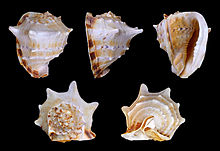Cassis cornuta
| Cassis cornuta | |
|---|---|
 |
|
| A shell of Cassis cornuta | |
 |
|
| Five views of a shell of Cassis cornuta | |
| Scientific classification | |
| Kingdom: | Animalia |
| Phylum: | Mollusca |
| Class: | Gastropoda |
| (unranked): | clade Caenogastropoda clade Hypsogastropoda clade Littorinimorpha |
| Superfamily: | Tonnoidea |
| Family: | Cassidae |
| Subfamily: | Cassinae |
| Genus: | Cassis |
| Subgenus: | Cassis |
| Species: | C. cornuta |
| Binomial name | |
|
Cassis cornuta (Linnaeus, 1758) |
|
| Synonyms | |
|
|
Cassis cornuta, common name the horned helmet, is a species of extremely large sea snail, a marine gastropod mollusc in the family Cassidae, the helmet shells and their allies.
The length of the shell varies between 50 mm and 410 mm. It is the largest of all helmet shells. It has a very solid, heavy, rotund shell with large, horn-like knobs and a wide, flat base. The shell has a dorsally pale orange colour, its base vivid orange, faintly marked with white and brown.
This large sea snail is found on sand and coral rubble, often around reefs.
This species occurs in the Red Sea, the Indian Ocean, off the southern African coast from northern KwaZulu-Natal and from Mozambique, as well as in the Pacific Ocean.
The shell of Cassis cornuta is a very popular collector's item. In some places the snail is hunted for meat and is traditionally roasted in the shell over fire. Because of both of these factors, humans are a major enemy, and the species is now at risk in many places. However, worldwide it is not listed in the Red List. Because this snail hunts the crown-of-thorns starfish, which feed on corals, Cassis cornuta has been put under strict protection in Queensland.
...
Wikipedia
